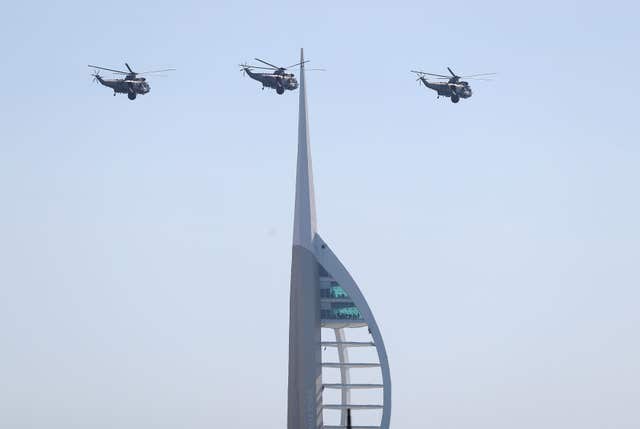
Three Royal Navy Sea King helicopters have made their final flight before retirement, bringing to an end 49 years of service for the “indispensable” aircraft.
The helicopters, whose predecessors were introduced into service three weeks after the first moon landing, flew over Portsmouth Naval Base to their final destination of HMS Sultan in Gosport, Hampshire, where they will await disposal.
The flight from their base at RNAS Culdrose in Cornwall took them past the Navy’s hi-tech destroyer HMS Diamond and Portsmouth’s landmark Spinnaker Tower.
Mission complete for the Bags! After years of outstanding operational success, the last Sea King Mk7 helicopters have left @RNASCuldrose for the last time & passed the ASaC baton to the Merlin Mk2. What awesome memories we have ⚓️ 🇬🇧⚓️ #FinalFlight #SeaKing #eyesinthesky pic.twitter.com/nMUadTrnZT
— RNAS Culdrose (@RNASCuldrose) September 26, 2018
A total of 140 Sea Kings were built for the Royal Navy in their almost half-century of service.
They have been used for anti-submarine warfare, search-and-rescue missions, general duties, carrying Royal Marines commandos into action in the Falklands, Iraq, the Balkans, Sierra Leone and Afghanistan.
The helicopters, nicknamed baggers, also provided airborne early warning and intelligence to the fleet and ground forces.

A Navy spokesman said: “It earned the ‘bagger’ tag after the Falklands conflict in 1982 when the airborne early warning variant was hurriedly introduced.
“The large black sack sticking out of the fuselage houses a powerful radar which scans the skies for potential threats.
“Those original baggers had one major flaw – they couldn’t track hostile aircraft over land, a problem rectified when the much-improved MK7 entered service in 2001.
“It proved to be a revelation. Crews found that they could not only detect aerial threats, but they could also track vehicle movements on the ground.
“The MK7 proved indispensable in helping Allied forces to evade and ultimately destroy Saddam Hussein’s army around Basra and the Al Faw peninsula in 2003.
“They also helped ground troops and police in Afghanistan arrest insurgents and seize masses of weapons and bomb-making equipment.”
The airborne surveillance and control role will be taken over by the new Merlin Crowsnest, which arrives at Culdrose next year and will operate from new carriers HMS Queen Elizabeth and Prince of Wales from 2020.


Comments: Our rules
We want our comments to be a lively and valuable part of our community - a place where readers can debate and engage with the most important local issues. The ability to comment on our stories is a privilege, not a right, however, and that privilege may be withdrawn if it is abused or misused.
Please report any comments that break our rules.
Read the rules here